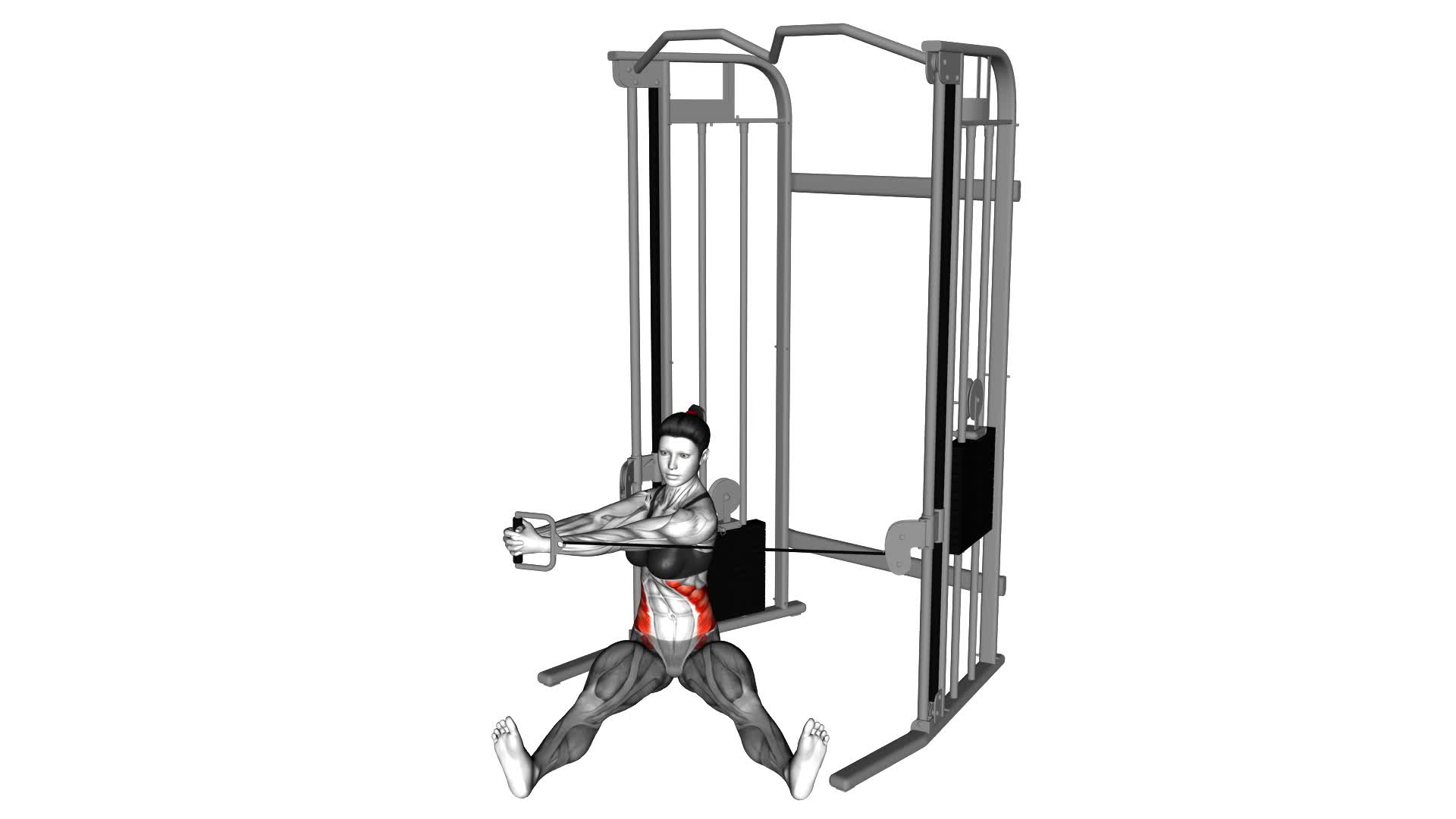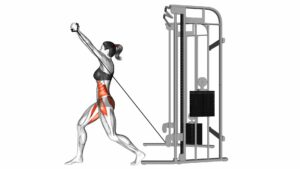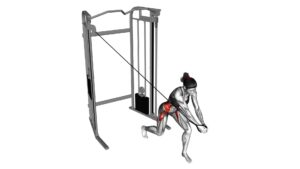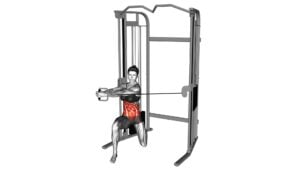Cable Seated Twist on Floor (female) – Video Exercise Guide & Tips

Get ready to strengthen your core and improve your flexibility with the Cable Seated Twist on Floor. In this video exercise guide, we'll show you the proper form and technique to perform this exercise.
Watch This Exercise Video
Whether you're a beginner or advanced, we've got modifications for every level. Ladies, this exercise is especially beneficial for you. Maximize your results and avoid common mistakes with our helpful tips.
Let's get started!
Key Takeaways
- Engaging the core muscles is important during the Cable Seated Twist on Floor exercise.
- Proper breathing technique, such as deep breaths and exhaling during the twist, aids in relaxation and muscle oxygenation.
- Starting with light weights allows beginners to focus on form and gradually build strength, improving confidence and motivation.
- Progressing with resistance increases muscle activation, enhances strength gains, and prevents plateauing.
Equipment Needed for Cable Seated Twist on Floor
To perform the Cable Seated Twist on the floor, you'll need a single cable machine. This exercise is highly beneficial for targeting your obliques, core muscles, and improving spinal mobility. The cable machine provides constant tension throughout the movement, making it an effective way to strengthen and tone your abdominal muscles.
There are several variations of the Cable Seated Twist that you can try to add variety to your workout routine. One variation is the seated twist with a resistance band. Instead of using a cable machine, you can attach a resistance band to a sturdy anchor point and perform the twist in a seated position. This variation allows for more freedom of movement and is a great option for those who don't have access to a cable machine.
Another variation is the standing cable twist. Instead of sitting on the floor, you stand facing the cable machine with the handle at chest height. You then twist your torso to one side, keeping your hips stable and engaging your core muscles. This variation adds an element of balance and stability to the exercise.
Incorporating the Cable Seated Twist into your workout routine can help improve your core strength, stability, and flexibility. It's important to start with light weights and gradually increase the resistance as your strength improves. Remember to maintain proper form and engage your core muscles throughout the movement for maximum effectiveness.
Proper Form and Technique for Cable Seated Twist on Floor
To ensure proper form and technique for the Cable Seated Twist on the floor, follow these guidelines.
First, start by sitting on the floor with your legs extended in front of you. Position the cable machine at your side and grasp the handle with both hands. Keep your back straight and engage your core muscles throughout the exercise.
As you twist, exhale and rotate your torso to the opposite side, pulling the cable across your body. Be sure to maintain control and avoid using momentum to swing the cable. Slowly return to the starting position and repeat on the other side.
To maximize the effectiveness of the Cable Seated Twist, it's important to avoid common mistakes. Avoid rounding your back or hunching your shoulders, as this can put strain on your spine. Additionally, don't use excessive weight that compromises your form. Focus on using a weight that allows you to perform the exercise with proper technique.
For variations to accommodate different fitness levels, you can adjust the weight of the cable or the number of repetitions. Beginners may start with lighter weights and fewer repetitions, while more advanced individuals can increase the weight and perform more repetitions. Remember to listen to your body and progress at a pace that feels challenging yet safe.
Modifications for Beginners and Advanced Levels
If you're a beginner or at an advanced level, you can modify the Cable Seated Twist exercise to suit your fitness needs. For beginners, it's important to start with lighter weights or resistance bands to avoid strain or injury. You can also reduce the range of motion by twisting only halfway or using a smaller range of motion until you build up strength and flexibility. Pregnant women should consult their healthcare provider before attempting this exercise. Modifications for pregnant women may include using lighter weights, reducing the range of motion, or avoiding the exercise altogether if it feels uncomfortable or causes any pain.
For athletes or those at an advanced level, you can increase the difficulty of the Cable Seated Twist by using heavier weights or resistance bands. This will challenge your core muscles even more and help improve rotational power and stability. You can also try adding a stability ball or Bosu ball to the exercise to engage more muscles and improve balance. Another variation for athletes is to perform the Cable Seated Twist in a standing position, which adds an element of balance and stability.
Remember to always listen to your body and modify the exercise as needed to prevent any injuries or discomfort.
Benefits of Cable Seated Twist on Floor for Females
You will frequently reap the benefits of the Cable Seated Twist on the floor as a female, as it targets and strengthens your core muscles. Core strengthening exercises for women are essential for overall strength, stability, and posture. The Cable Seated Twist specifically focuses on the rotational movement of the core, which is important for female fitness routines.
Many daily activities, such as reaching for objects or twisting to look behind you, require rotational movements. By incorporating rotational exercises like the Cable Seated Twist into your fitness routine, you can improve your functional strength and prevent injuries in everyday life.
Additionally, rotational exercises engage the obliques, which are the muscles on the sides of your core. Strengthening these muscles can help create a more defined waistline and enhance your overall physique.
The Cable Seated Twist on the floor is a versatile exercise that can be adjusted to your fitness level by adjusting the weight on the cable machine. It also allows you to control the range and speed of the movement, making it suitable for beginners and advanced individuals alike.
Tips to Maximize Results and Avoid Common Mistakes
To maximize your results and avoid common mistakes while performing the Cable Seated Twist on the floor, focus on maintaining proper form and engaging your core muscles throughout the exercise.
Here are some tips to help you get the most out of this exercise and prevent lower back pain:
- Keep your spine straight: Avoid rounding your back or slouching during the twist. Maintaining a straight spine will help protect your lower back and target your core muscles effectively.
- Engage your core: Throughout the exercise, consciously engage your core muscles by pulling your belly button towards your spine. This will maximize your core strength and stability.
- Control the movement: Avoid using momentum to twist or jerk your body. Instead, focus on controlled movements, rotating from your waist and using your core muscles to initiate the twist.
- Breathe deeply: Remember to breathe deeply and exhale as you twist to fully engage your core muscles and promote relaxation.
- Start with light weights: If you're new to this exercise, start with light weights or no weights at all. Gradually increase the resistance as you build strength and improve your form.
Frequently Asked Questions
How Many Sets and Reps Should I Do for the Cable Seated Twist on Floor Exercise?
To determine the number of sets and reps for the cable seated twist on floor exercise, consider the benefits and variations of the exercise.
The cable seated twist on floor targets your obliques and core muscles, promoting increased strength and stability.
As for variations, you can adjust the resistance or use different attachments to target specific areas.
Start with 2-3 sets of 10-12 reps, and gradually increase as your strength improves.
Remember to maintain proper form and consult a professional if needed.
Can Men Also Benefit From Doing the Cable Seated Twist on Floor Exercise?
Yes, men can definitely benefit from doing the cable seated twist on the floor exercise.
This exercise helps to strengthen and tone the core muscles, improve spinal mobility, and increase overall stability.
It also targets the obliques, which are important for rotational movements.
Adding the cable resistance can provide a greater challenge and help build stronger muscles.
Is It Necessary to Warm up Before Performing the Cable Seated Twist on Floor Exercise?
Before performing the cable seated twist on the floor exercise, it's important for you to warm up your body. Warming up helps increase blood flow, flexibility, and prepares your muscles for the workout.
Additionally, it's crucial to maintain proper form during this exercise to avoid any injuries and maximize its benefits. Focus on engaging your core, keeping your back straight, and using controlled movements.
Can I Do the Cable Seated Twist on Floor Exercise if I Have a History of Lower Back Pain?
To prevent lower back pain during exercise, it's important to consider your history of lower back pain. If you have a history of this pain, it's recommended to consult with a healthcare professional before attempting the cable seated twist on floor exercise.
They can provide guidance on modifications or alternative exercises that can help protect your lower back. It's always better to be safe and cautious when it comes to exercising, especially if you have a pre-existing condition.
Are There Any Alternative Exercises That Target the Same Muscle Groups as the Cable Seated Twist on Floor Exercise?
If you're looking for alternative exercises that target the same muscle groups as the cable seated twist on the floor, there are a few options you can try.
One option is the Russian twist, which also works the obliques and core muscles.
Another exercise is the seated medicine ball twist, which helps strengthen the abs and obliques.
Lastly, you can consider doing standing side bends with dumbbells to engage the obliques and strengthen the core.
Conclusion
Overall, the cable seated twist on the floor is a beneficial exercise for females looking to strengthen their core and improve their overall fitness. With the proper form and technique, this exercise can help target the obliques and increase flexibility.
By incorporating modifications and gradually increasing intensity, beginners and advanced individuals can benefit from this exercise. Remember to follow the tips provided to maximize your results and avoid common mistakes.

Author
Years ago, the spark of my life’s passion ignited in my mind the moment I stepped into the local gym for the first time. The inaugural bead of perspiration, the initial endeavor, the very first surge of endorphins, and a sense of pride that washed over me post-workout marked the beginning of my deep-seated interest in strength sports, fitness, and sports nutrition. This very curiosity blossomed rapidly into a profound fascination, propelling me to earn a Master’s degree in Physical Education from the Academy of Physical Education in Krakow, followed by a Sports Manager diploma from the Jagiellonian University. My journey of growth led me to gain more specialized qualifications, such as being a certified personal trainer with a focus on sports dietetics, a lifeguard, and an instructor for wellness and corrective gymnastics. Theoretical knowledge paired seamlessly with practical experience, reinforcing my belief that the transformation of individuals under my guidance was also a reflection of my personal growth. This belief holds true even today. Each day, I strive to push the boundaries and explore new realms. These realms gently elevate me to greater heights. The unique combination of passion for my field and the continuous quest for growth fuels my drive to break new ground.







